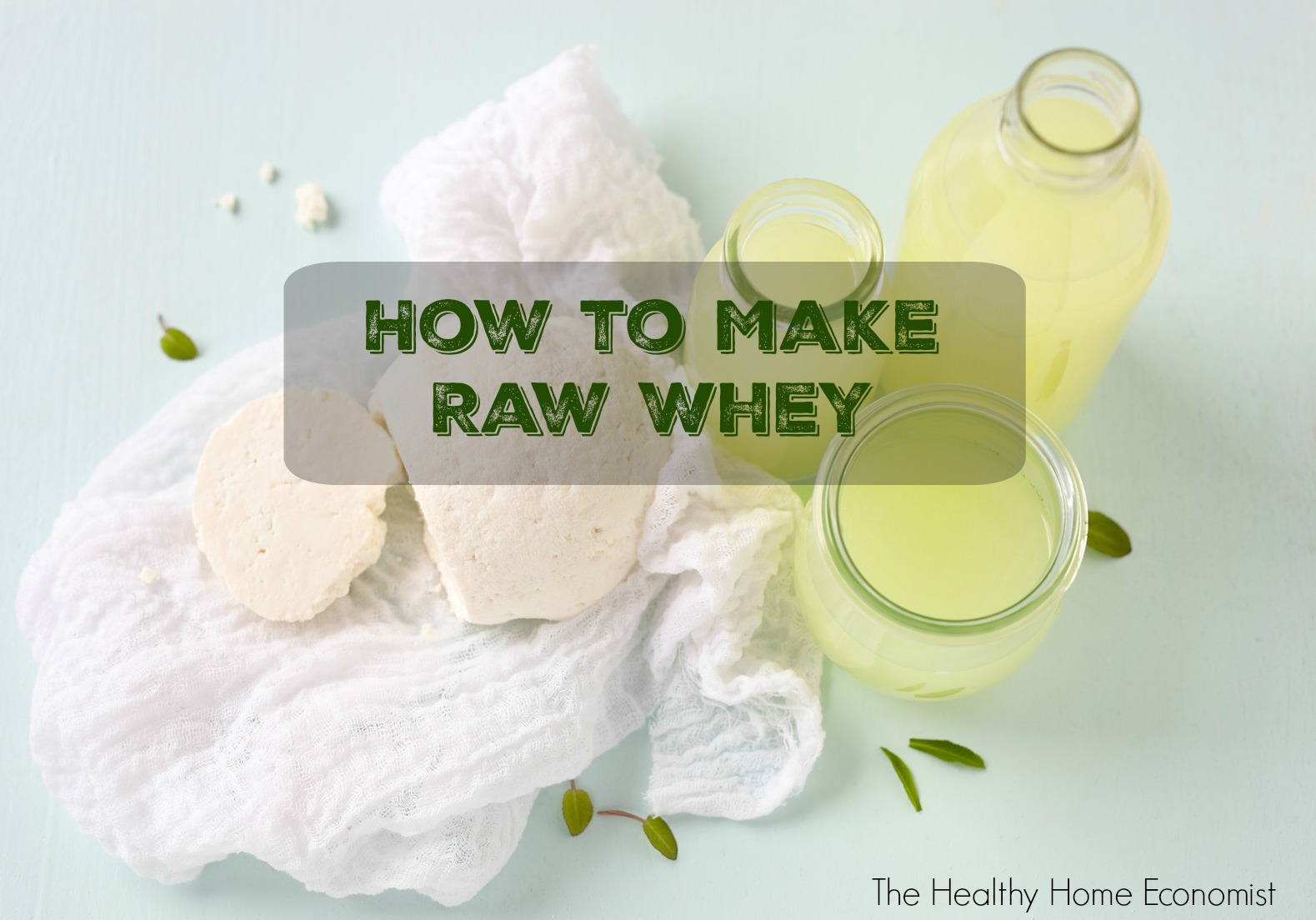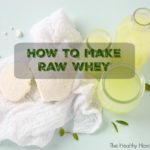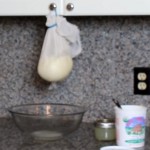How to make raw, enzyme and probiotic-rich liquid whey to use as a starter culture for all your home fermentation needs.

Do you know how to make whey from yogurt, kefir or raw milk?
A by-product of this simple technique is healthy homemade cream cheese that is loaded with enzymes and probiotics.
The recipe below describes how with visual instructions via video demonstration!
Making homemade baby formula? I recommend using this “quick whey” no straining method as the fastest and easiest approach.
How to Make Whey the REAL Way
Making real, liquid, nutrient rich, unadulterated whey in your own kitchen is a MUST step for any traditional cook to learn.
Without whey in its whole, liquid form, many other traditional recipes cannot even be attempted. You cannot buy whey from the store except in a denatured, unhealthy, powdered whey form. It is worth your time to learn what I show you in the video below.
Other video lessons on this blog show you how to use this whole food form of whey to make many delicious, healthful recipes for your family. Whey as made in the video demo below will keep up to 6 months in the refrigerator in a sealed mason jar.
If you absolutely have no access to farm fresh milk to make whole, unadulterated, enzyme rich whey, then you can use plain, organic yogurt brand from the store instead. Here are tips on how to spot the best yogurt brands.
The process is basically exactly the same thing as shown in the video.
You won’t get nearly as much whey using yogurt as clabbered, farm fresh milk, but at least you can get enough to get you started.
Wonderful Whey and REAL Cream Cheese
The raw, enzyme-rich cream cheese I make in the recipe video below is fantastic on a sprouted or sourdough bagel for breakfast. Don’t buy the Ezekiel sprouted muffins as they contain soy. This low-carb bagel recipe is another great one to try.
If you prefer to buy, these sourdough bagels are available for shipping freshly made to your door.
To make, just take your cream cheese left over from making liquid whey and add a few strawberries and a dash of dark maple syrup to taste. Mix together by pulsing a few times in your food processor. This wonderful, fresh, REAL strawberry cream cheese will last one to two weeks in the refrigerator. Another wonderful use for this healthy raw cheese is to make an easy no bake cheesecake.
No access to raw milk where you live? No problem. Check out this recipe plus video on how to separate whey from yogurt purchased from the store.
Cloudy Whey vs Clear Whey
No matter whether your whey turns out cloudy or clear, it is safe and fine to use in all your favorite recipes. This article explains why sometimes whey is cloudy compared to its usual golden color.

Raw Whey Recipe
How to separate raw, liquid whey from clabbered milk. The process also creates probiotic rich cream cheese.
Ingredients
- 1 quart raw milk preferably grassfed
- 1 large glass bowl
- 1 large rubber band
- 1 white dishtowel
Instructions
-
Allow the raw milk to sit on the counter for 1-3 days at room temperature.
-
When the milk separates into curds and whey (transforms into clabbered milk) you are ready to proceed. Note that the fresher the raw milk and the colder the temperature of your house, the longer it will take the raw milk to clabber.
-
Line a clean, large glass bowl with a clean, white dishtowel that isn’t too thick. Cheesecloth will also work, but the holes in the mesh must be very small, else the milk curds will pass through.
-
Gently pour the clabbered milk into the middle of the dish towel. Gather up the ends and fasten with a rubber band. Attach to a knob on an upper cabinet in your kitchen as shown in the picture.

-
Let the raw whey drip into the bowl underneath. This process will continue for an hour or two.
-
After the dripping stops, gently take down the hanging bag and place it into a clean bowl. Scrape out the raw cream cheese that is inside the bag, put in a container with a lid and refrigerate.
-
Pour the liquid whey from the dripping bowl into a glass mason jar, afix the lid and refrigerate.
-
Refrigerated, raw cream cheese will be good to eat for about a week. Raw whey will last several months refrigerated.
Recipe Video
How to Use Whey in Recipes
How to Make Ricotta Three Ways (plus Video How-to)
Perfect Probiotic Cottage Cheese
Cheese Making: Common Problems and Solutions








Hi Sarah,
I have a 1/2 of a gallon of 3-4 week old soured milk in my frig. When I took it out today and strained it, a solid clump of milk solid came tumbling out. Is this stuff cream cheese?
Hi Lori, yes by all means freeze what you cannot use. It thaws nicely.
Hi Sarah.
Thanks for the video, and I have a question for you. Can you freeze the cream cheese? I am wondering because if one makes a large quantity at a time and not enough is eaten quickly, is it possible to freeze some of the cream cheese for later? Thanks!
Hi Teri, that is a great question that I really am not sure the answer to. Nourishing Traditions cookbook says that the milk to make whey and cream cheese should be nonhomogenized and raw goat milk is naturally homogenized, as you know. If you give it a try, please comment again and let us know if it works!
does this work with raw goat milk from our goats?
Hi Alina,
Yes, you can make liquid whey and kefir cheese instead of cream cheese/liquid whey if you like. Just use kefir instead of clabbered milk. Adding the kefir grains to the clabbered milk is fine if you want to do it that way. The kefir cheese might turn out a bit strong tasting though .. I would make kefir with fresh milk first and then just strain into liquid whey/kefir cheese.
Hi Sarah,
What do you think about adding kefir grains or Fil Mjolk culture to the clabbering milk and making the cream cheese from it? Does it make sense?
Hi Dale, yes what you have is the same as the whey I made in the video from clabbered milk! Your whey is fine and has live cultures in it as it came from yogurt.
Is it true that heating the milk past 110 degrees kills most of the good stuff? Most recipes I find for making yogurt w/ raw milk say to heat to 110 for that reason. So, if it is true… then wouldn’t the whey strained from that be less beneficial too?
Hi Sarah,
I'm quite the newbie, so please excuse me if this question seems like a no-brainer.
I made some yogurt from real milk which required heating it to 180°. Because it was a little too runny at completion, I chose to strain it through a flour sack cloth. Wow, I came up with about 18oz of whey. My question is: Is this whey, strained from my yogurt, the same as whey strained from clabbered milk, or did heating it change it so as to prevent it from being used like whey from clabbered milk?
Thanks…
Hi Alina, you can put fresh milk that hasn't soured on the counter to clabber, it just might take a few days for this to happen rather than 1 day if the milk was already sour. No, you cannot strain clabbered milk with a sieve as too much of the milkfat will pass through the sieve and you won't separate the whey well enough this way. You must use a clean, white cloth as shown in the video.